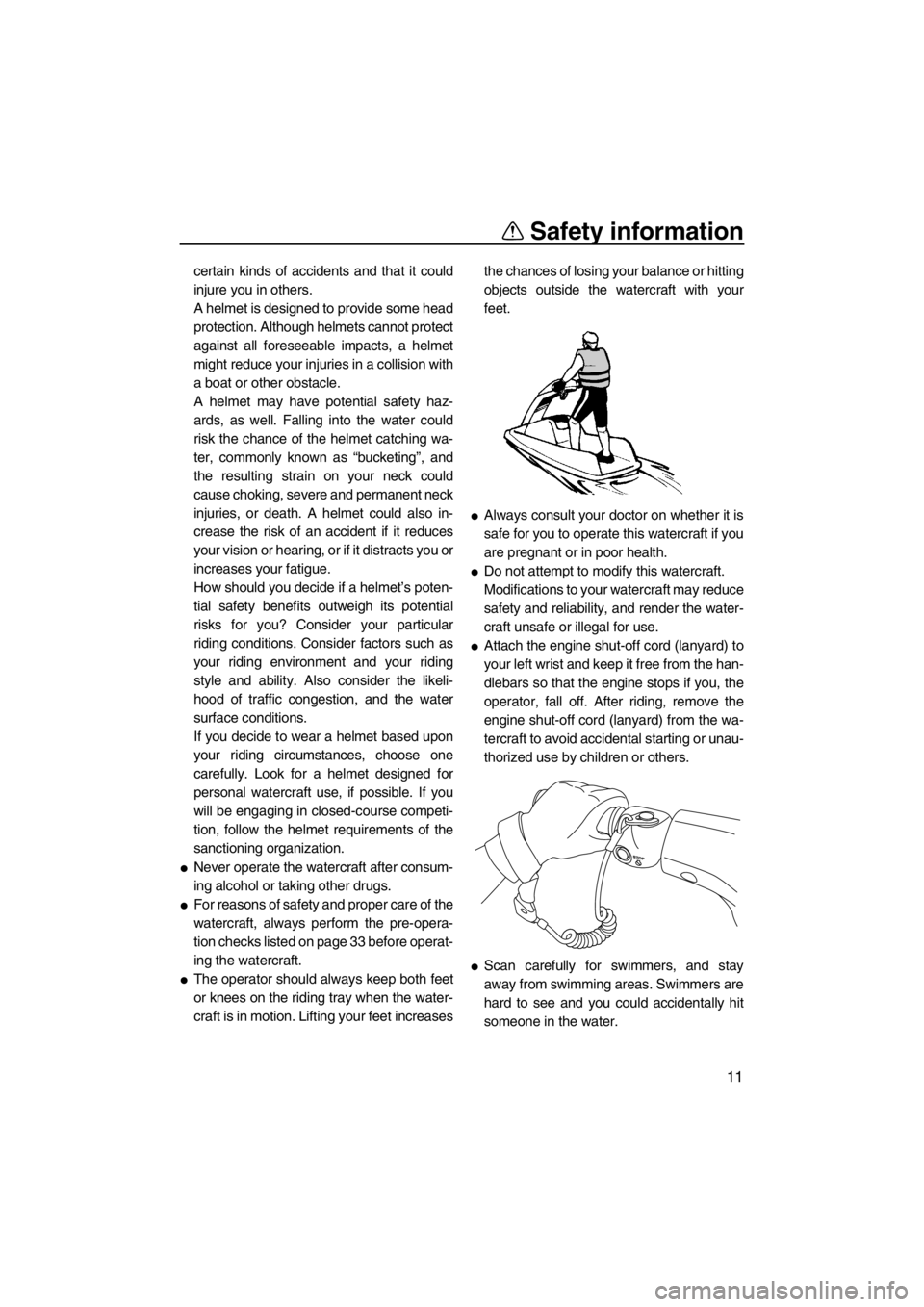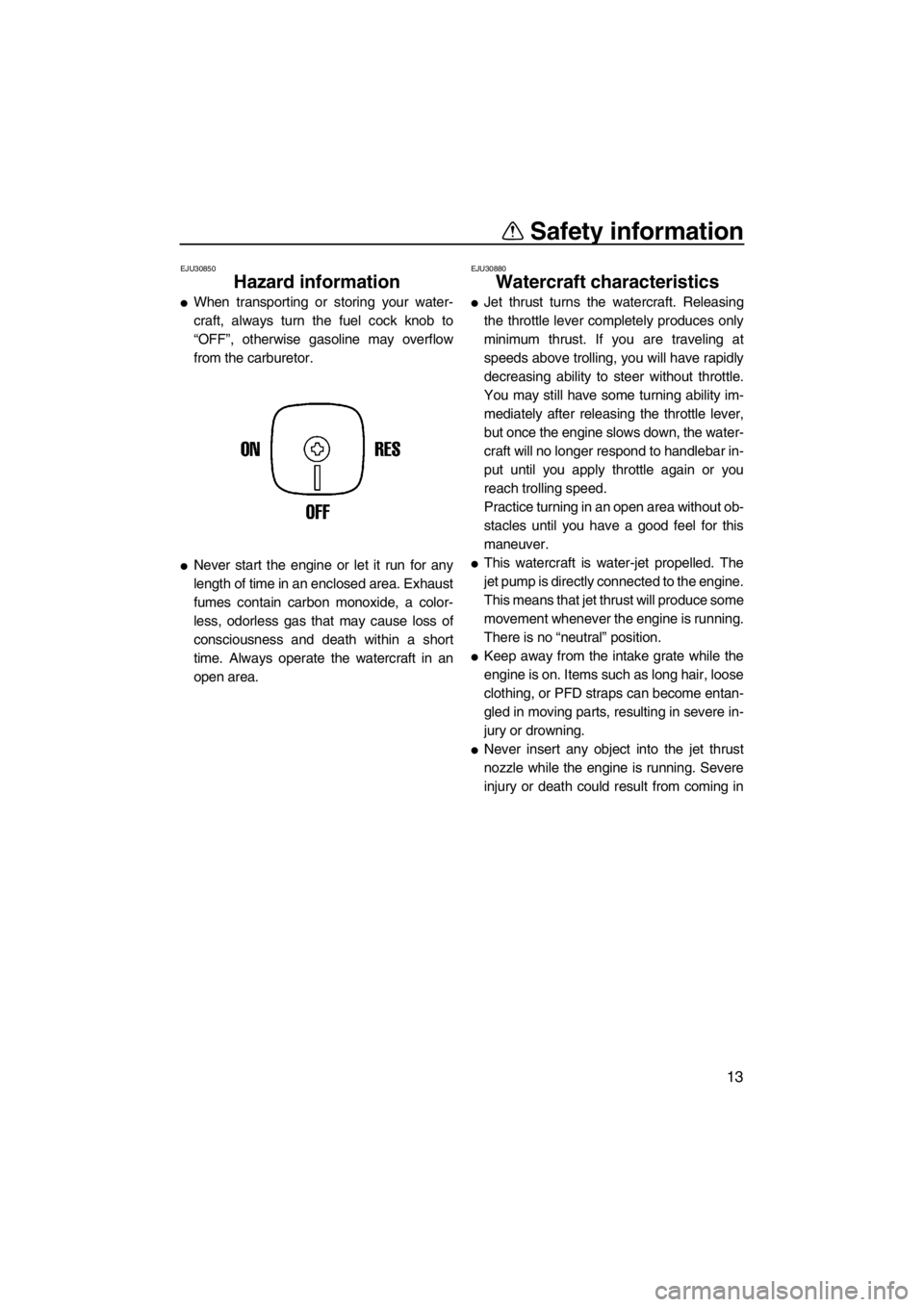Page 17 of 78

Safety information
11
certain kinds of accidents and that it could
injure you in others.
A helmet is designed to provide some head
protection. Although helmets cannot protect
against all foreseeable impacts, a helmet
might reduce your injuries in a collision with
a boat or other obstacle.
A helmet may have potential safety haz-
ards, as well. Falling into the water could
risk the chance of the helmet catching wa-
ter, commonly known as “bucketing”, and
the resulting strain on your neck could
cause choking, severe and permanent neck
injuries, or death. A helmet could also in-
crease the risk of an accident if it reduces
your vision or hearing, or if it distracts you or
increases your fatigue.
How should you decide if a helmet’s poten-
tial safety benefits outweigh its potential
risks for you? Consider your particular
riding conditions. Consider factors such as
your riding environment and your riding
style and ability. Also consider the likeli-
hood of traffic congestion, and the water
surface conditions.
If you decide to wear a helmet based upon
your riding circumstances, choose one
carefully. Look for a helmet designed for
personal watercraft use, if possible. If you
will be engaging in closed-course competi-
tion, follow the helmet requirements of the
sanctioning organization.
●Never operate the watercraft after consum-
ing alcohol or taking other drugs.
●For reasons of safety and proper care of the
watercraft, always perform the pre-opera-
tion checks listed on page 33 before operat-
ing the watercraft.
●The operator should always keep both feet
or knees on the riding tray when the water-
craft is in motion. Lifting your feet increasesthe chances of losing your balance or hitting
objects outside the watercraft with your
feet.
●Always consult your doctor on whether it is
safe for you to operate this watercraft if you
are pregnant or in poor health.
●Do not attempt to m
odify this watercraft.
Modifications to your watercraft may reduce
safety and reliability, and render the water-
craft unsafe or illegal for use.
●Attach the engine shut-off cord (lanyard) to
your left wrist and keep it free from the han-
dlebars so that the engine stops if you, the
operator, fall off. After riding, remove the
engine shut-off cord (lanyard) from the wa-
tercraft to avoid accidental starting or unau-
thorized use by children or others.
●Scan carefully for swimmers, and stay
away from swimming areas. Swimmers are
hard to see and you could accidentally hit
someone in the water.
UF2F75E0.book Page 11 Thursday, July 5, 2012 8:50 AM
Page 18 of 78

Safety information
12
●Avoid being hit by another boat. You should
always take the responsibility to watch for
traffic; other boaters may not be watching
for you. If they do not see you, or if you ma-
neuver more quickly than other boaters ex-
pect, you risk a collision.
●Maintain a safe distance from other boats
and watercraft, and also watch for ski ropes
or fishing lines. Obey the “Safe boating
rules” and be sure to check behind you be-
fore making a turn. (See “Safe boating
rules” on page 14.)
EJU30840
Recommended equipment
The following items should be carried on
board your watercraft:
●Sound-signaling device
You should carry a whistle or other sound-
signaling device that can be used to signal
other boats.
●Visual distress signals
It is recommended that a pyrotechnic de-
vice, which is approved by the appropriate
authorities, be stored in a waterproof con-
tainer on your watercraft. A mirror can also
be used as an emergency signal. Contact a
Yamaha dealer for more information.
●Watch
A watch is helpful so you will know how long
you have been operating the watercraft.
●Towline
A towline can be used to tow a disabled wa-
tercraft in an emergency.
UF2F75E0.book Page 12 Thursday, July 5, 2012 8:50 AM
Page 19 of 78

Safety information
13
EJU30850
Hazard information
●When transporting or storing your water-
craft, always turn the fuel cock knob to
“OFF”, otherwise gasoline may overflow
from the carburetor.
●Never start the engine or let it run for any
length of time in an enclosed area. Exhaust
fumes contain carbon monoxide, a color-
less, odorless gas that may cause loss of
consciousness and death within a short
time. Always operate the watercraft in an
open area.
EJU30880
Watercraft characteristics
●Jet thrust turns the watercraft. Releasing
the throttle lever completely produces only
minimum thrust. If you are traveling at
speeds above trolling, you will have rapidly
decreasing ability to steer without throttle.
You may still have some turning ability im-
mediately after releasing the throttle lever,
but once the engine slows down, the water-
craft will no longer respond to handlebar in-
put until you apply throttle again or you
reach trolling speed.
Practice turning in an open area without ob-
stacles until you have a good feel for this
maneuver.
●This watercraft is water-jet propelled. The
jet pump is directly connected to the engine.
This means that jet thrust will produce some
movement whenever the engine is running.
There is no “neutral” position.
●Keep away from the intake grate while the
engine is on. Items such as long hair, loose
clothing, or PFD straps can become entan-
gled in moving parts, resulting in severe in-
jury or drowning.
●Never insert any object into the jet thrust
nozzle while the engine is running. Severe
injury or death could result from coming in
UF2F75E0.book Page 13 Thursday, July 5, 2012 8:50 AM
Page 20 of 78
Safety information
14
contact with the rotating parts of the jet
pump.
●Stop the engine and remove the clip from
the engine shut-off switch before removing
any debris or weeds, which may have col-
lected around the jet intake.
●Avoid forceful jet thrust and limited visibility
while reboarding. Get to a standing or
kneeling position quickly, but do not expose
yourself to the forceful jet thrust.
EJU30970
Safe boating rules
Your Yamaha watercraft is legally considered
a powerboat. Operation of the watercraft must
be in accordance with the rules and regula-
tions governing the waterway on which it is
used.
1Intake grate
2 Jet thrust nozzle
1 Clip
2 Engine shut-off switch
STOP
2
1
UF2F75E0.book Page 14 Thursday, July 5, 2012 8:50 AM
Page 21 of 78

Safety information
15
EJU30991
Enjoy your watercraft responsibly
You share the areas you enjoy when riding
your watercraft with others and with nature.
So your enjoyment includes a responsibility to
treat these other people, and the lands, wa-
ters, and wildlife with respect and courtesy.
Whenever and wherever you ride, think of
yourself as the guest of those around you. Re-
member, for example, that the sound of your
watercraft may be music to you, but it could be
just noise to others. And the exciting splash of
your wake can make waves others won’t en-
joy.
Avoid riding close to shoreline homes and wa-
terfowl nesting areas or other wildlife areas,
and keep a respectful distance from fisher-
men, other boats, swimmers, and populated
beaches. When travel in areas like these is
unavoidable, ride slowly and obey all laws.
Proper maintenance is necessary to ensure
that the exhaust emission and sound levels of
your watercraft will continue to be within regu-
lated limits. You have the responsibility to
make sure that the recommended mainte-
nance in this owner’s/operator’s manual is
carried out.
Remember, pollution can be harmful to the
environment. Do not refuel or add oil where a
spill could cause damage to nature. Remove
your watercraft from the water and move it
away from the shoreline before refueling. Dis-
pose of water and any fuel and oil residue in
the engine compartment according to local
regulations. And keep your surroundings
pleasant for the people and wildlife that share
the waterways: don’t litter.
When you ride responsibly, with respect and
courtesy for others, you help ensure that our waterways stay open for the enjoyment of a
variety of recreational opportunities.
UF2F75E0.book Page 15 Thursday, July 5, 2012 8:50 AM
Page 22 of 78
Description
16
EJU40652
Watercraft glossary
Trolling speed
“Trolling” is the lowest maneuvering speed. You are applying little or no throttle. The watercraft
is down in the water, and there is no wake.
Sub-planing speed
“Sub-planing” is a medium speed. The bow of the watercraft is slightly up from the water sur-
face, but you are still traveling through the water. There is a wake.
Planing speed
“Planing” is a faster speed. The watercraft is more level and is skimming on top of the water.
There is a wake.
Bow
The front end of the watercraft.
Stern
The rear end of the watercraft.
Starboard
The right side of the watercraft when facing forward.
Port
The left side of the watercraft when facing forward.
Bilge water
Water that has collected in the engine compartment.
UF2F75E0.book Page 16 Thursday, July 5, 2012 8:50 AM
Page 23 of 78
Description
17
EJU31011
Location of main components
2
1
3 456
7
8
9
10 11 12 13 15 16
1Steering pole
2 Steering pole cover
3 Bow rope hole
4 Fuel filler cap
5 Cooling water pilot outlet
6 Hood
7 Hood latch
8 Handlebars
9 Storage pouch
10 Riding tray
11 Stern rope hole
12 Jet thrust nozzle
13 Ride plate
14 Jet intake
15 Drive shaft
16 Intake grate
UF2F75E0.book Page 17 Thursday, July 5, 2012 8:50 AM
Page 24 of 78
Description
18
1Fire extinguisher container
2 Fuel cock knob
3 Choke knob
4 Clip
5 Start switch
6 Throttle lever
7 Engine shut-off cord (lanyard)
8 Engine stop switch
9 Engine shut-off switch
10 Fuel tank
11 Battery
12 Silencer
13 Spark plug/Spark plug cap
14 Water separator
15 Muffler
16 Fuel filter
17 Flushing hose connector
18 Electrical box
UF2F75E0.book Page 18 Thursday, July 5, 2012 8:50 AM